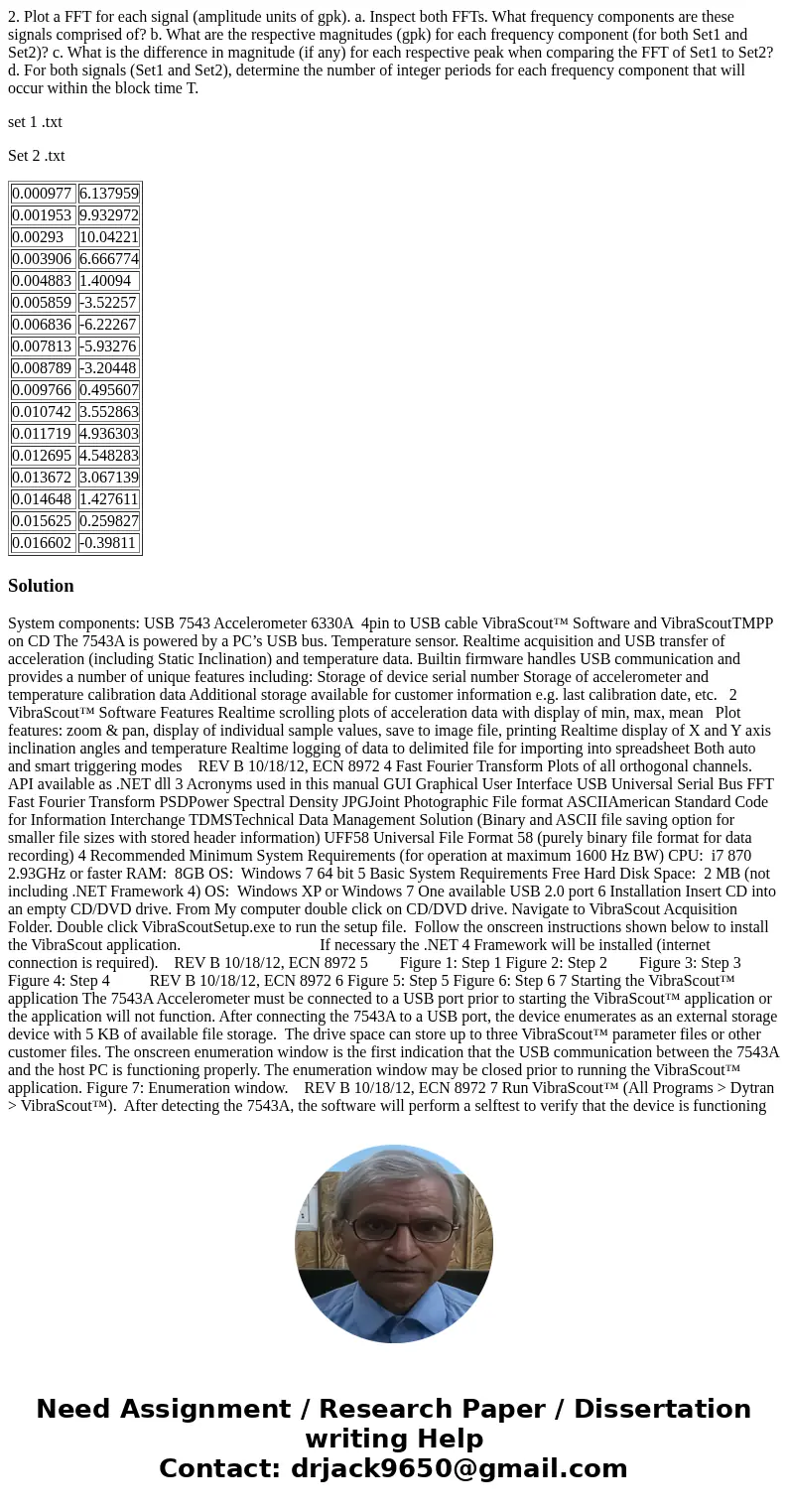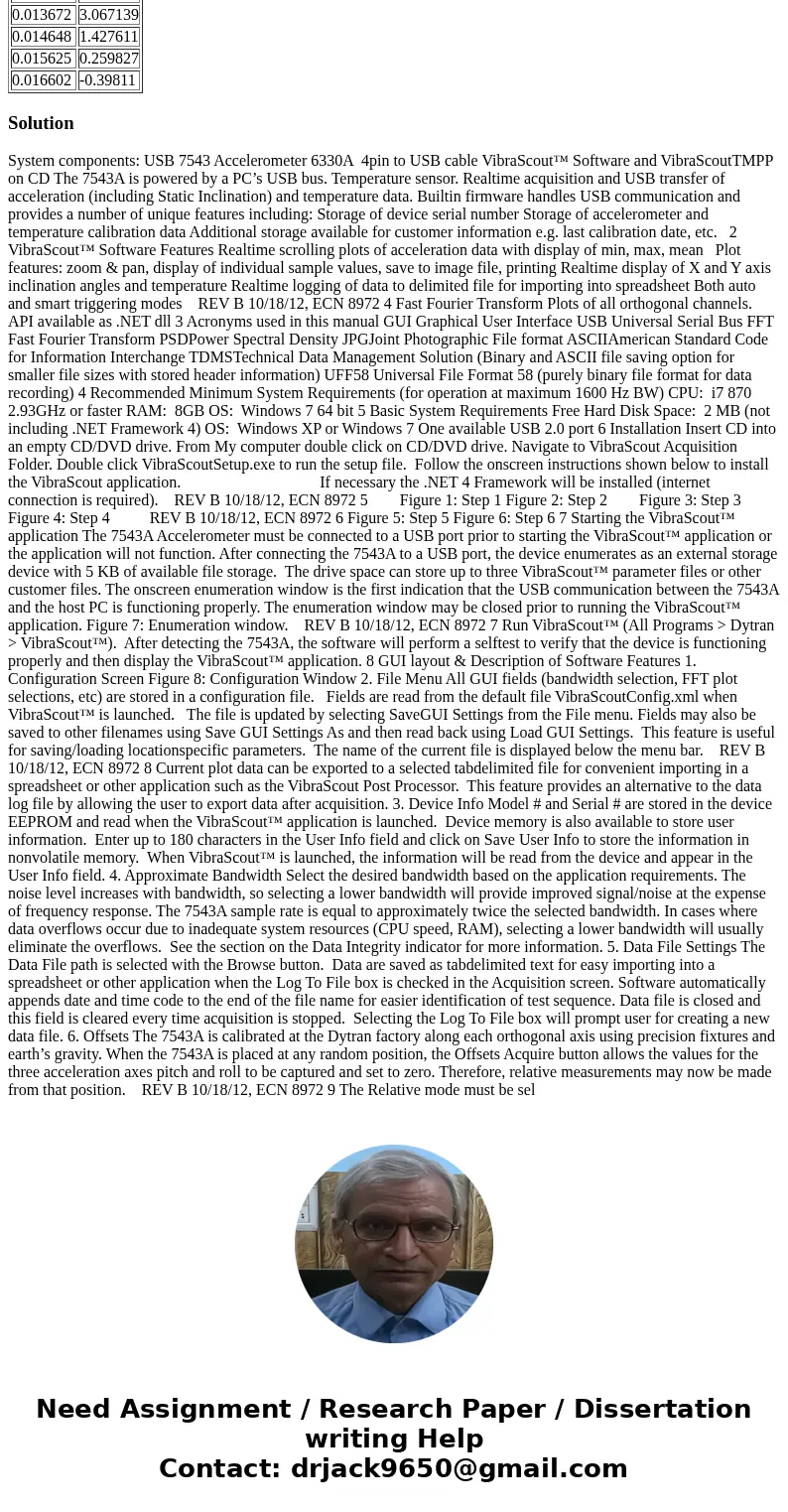2 Plot a FFT for each signal amplitude units of gpk a Inspec
2. Plot a FFT for each signal (amplitude units of gpk). a. Inspect both FFTs. What frequency components are these signals comprised of? b. What are the respective magnitudes (gpk) for each frequency component (for both Set1 and Set2)? c. What is the difference in magnitude (if any) for each respective peak when comparing the FFT of Set1 to Set2? d. For both signals (Set1 and Set2), determine the number of integer periods for each frequency component that will occur within the block time T.
set 1 .txt
Set 2 .txt
| 0.000977 | 6.137959 |
| 0.001953 | 9.932972 |
| 0.00293 | 10.04221 |
| 0.003906 | 6.666774 |
| 0.004883 | 1.40094 |
| 0.005859 | -3.52257 |
| 0.006836 | -6.22267 |
| 0.007813 | -5.93276 |
| 0.008789 | -3.20448 |
| 0.009766 | 0.495607 |
| 0.010742 | 3.552863 |
| 0.011719 | 4.936303 |
| 0.012695 | 4.548283 |
| 0.013672 | 3.067139 |
| 0.014648 | 1.427611 |
| 0.015625 | 0.259827 |
| 0.016602 | -0.39811 |
Solution
System components: USB 7543 Accelerometer 6330A 4pin to USB cable VibraScout™ Software and VibraScoutTMPP on CD The 7543A is powered by a PC’s USB bus. Temperature sensor. Realtime acquisition and USB transfer of acceleration (including Static Inclination) and temperature data. Builtin firmware handles USB communication and provides a number of unique features including: Storage of device serial number Storage of accelerometer and temperature calibration data Additional storage available for customer information e.g. last calibration date, etc. 2 VibraScout™ Software Features Realtime scrolling plots of acceleration data with display of min, max, mean Plot features: zoom & pan, display of individual sample values, save to image file, printing Realtime display of X and Y axis inclination angles and temperature Realtime logging of data to delimited file for importing into spreadsheet Both auto and smart triggering modes REV B 10/18/12, ECN 8972 4 Fast Fourier Transform Plots of all orthogonal channels. API available as .NET dll 3 Acronyms used in this manual GUI Graphical User Interface USB Universal Serial Bus FFT Fast Fourier Transform PSDPower Spectral Density JPGJoint Photographic File format ASCIIAmerican Standard Code for Information Interchange TDMSTechnical Data Management Solution (Binary and ASCII file saving option for smaller file sizes with stored header information) UFF58 Universal File Format 58 (purely binary file format for data recording) 4 Recommended Minimum System Requirements (for operation at maximum 1600 Hz BW) CPU: i7 870 2.93GHz or faster RAM: 8GB OS: Windows 7 64 bit 5 Basic System Requirements Free Hard Disk Space: 2 MB (not including .NET Framework 4) OS: Windows XP or Windows 7 One available USB 2.0 port 6 Installation Insert CD into an empty CD/DVD drive. From My computer double click on CD/DVD drive. Navigate to VibraScout Acquisition Folder. Double click VibraScoutSetup.exe to run the setup file. Follow the onscreen instructions shown below to install the VibraScout application. If necessary the .NET 4 Framework will be installed (internet connection is required). REV B 10/18/12, ECN 8972 5 Figure 1: Step 1 Figure 2: Step 2 Figure 3: Step 3 Figure 4: Step 4 REV B 10/18/12, ECN 8972 6 Figure 5: Step 5 Figure 6: Step 6 7 Starting the VibraScout™ application The 7543A Accelerometer must be connected to a USB port prior to starting the VibraScout™ application or the application will not function. After connecting the 7543A to a USB port, the device enumerates as an external storage device with 5 KB of available file storage. The drive space can store up to three VibraScout™ parameter files or other customer files. The onscreen enumeration window is the first indication that the USB communication between the 7543A and the host PC is functioning properly. The enumeration window may be closed prior to running the VibraScout™ application. Figure 7: Enumeration window. REV B 10/18/12, ECN 8972 7 Run VibraScout™ (All Programs > Dytran > VibraScout™). After detecting the 7543A, the software will perform a selftest to verify that the device is functioning properly and then display the VibraScout™ application. 8 GUI layout & Description of Software Features 1. Configuration Screen Figure 8: Configuration Window 2. File Menu All GUI fields (bandwidth selection, FFT plot selections, etc) are stored in a configuration file. Fields are read from the default file VibraScoutConfig.xml when VibraScout™ is launched. The file is updated by selecting SaveGUI Settings from the File menu. Fields may also be saved to other filenames using Save GUI Settings As and then read back using Load GUI Settings. This feature is useful for saving/loading locationspecific parameters. The name of the current file is displayed below the menu bar. REV B 10/18/12, ECN 8972 8 Current plot data can be exported to a selected tabdelimited file for convenient importing in a spreadsheet or other application such as the VibraScout Post Processor. This feature provides an alternative to the data log file by allowing the user to export data after acquisition. 3. Device Info Model # and Serial # are stored in the device EEPROM and read when the VibraScout™ application is launched. Device memory is also available to store user information. Enter up to 180 characters in the User Info field and click on Save User Info to store the information in nonvolatile memory. When VibraScout™ is launched, the information will be read from the device and appear in the User Info field. 4. Approximate Bandwidth Select the desired bandwidth based on the application requirements. The noise level increases with bandwidth, so selecting a lower bandwidth will provide improved signal/noise at the expense of frequency response. The 7543A sample rate is equal to approximately twice the selected bandwidth. In cases where data overflows occur due to inadequate system resources (CPU speed, RAM), selecting a lower bandwidth will usually eliminate the overflows. See the section on the Data Integrity indicator for more information. 5. Data File Settings The Data File path is selected with the Browse button. Data are saved as tabdelimited text for easy importing into a spreadsheet or other application when the Log To File box is checked in the Acquisition screen. Software automatically appends date and time code to the end of the file name for easier identification of test sequence. Data file is closed and this field is cleared every time acquisition is stopped. Selecting the Log To File box will prompt user for creating a new data file. 6. Offsets The 7543A is calibrated at the Dytran factory along each orthogonal axis using precision fixtures and earth’s gravity. When the 7543A is placed at any random position, the Offsets Acquire button allows the values for the three acceleration axes pitch and roll to be captured and set to zero. Therefore, relative measurements may now be made from that position. REV B 10/18/12, ECN 8972 9 The Relative mode must be sel


 Homework Sourse
Homework Sourse